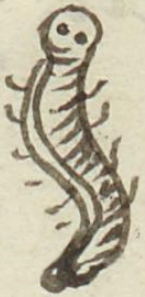Ocuil (MH680v)
This black-line drawing of the simplex glyph for the personal name Ocuil (“Worm”) is attested here as a man’s name. The glyph shows a profile view of a curvy worm, vertical with its head at the top. The head turns to provide a frontal view of the face, with both eyes showing, a style found on some insects, such as one of the glyphs for Xico (bumblebee) in this collection. The worm has a white belly. Its back is curved with stripes or a segmented body. Multiple legs emerge on both sides of the worm.
Stephanie Wood
The profusion of legs and the segmentation of the body suggests this worm may be a millipede or centipede. The millipede has shorter antennae than the centipede, and since antennae are not obvious in this drawing, perhaps this is a millipede.
Stephanie Wood
1560
Jeff Haskett-Wood
gusanos, milpiés, ciempiés, nombres de hombres

ocuil(in), worm, https://nahuatl.wired-humanities.org/content/ocuilin
Milpiés
Stephanie Wood
Matrícula de Huexotzinco, folio 680v, World Digital Library, https://www.loc.gov/resource/gdcwdl.wdl_15282/?sp=441&st=image.
This manuscript is hosted by the Library of Congress and the World Digital Library; used here with the Creative Commons, “Attribution-NonCommercial-ShareAlike 3.0 License” (CC-BY-NC-SAq 3.0).







